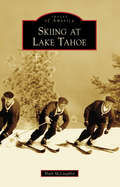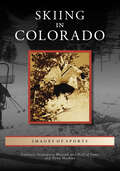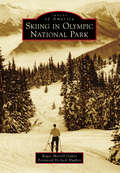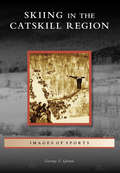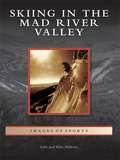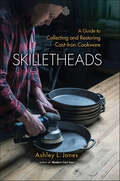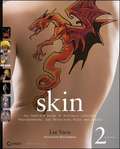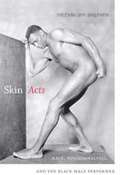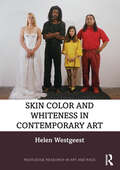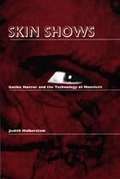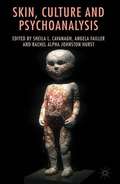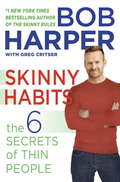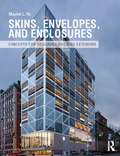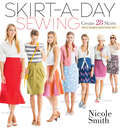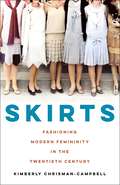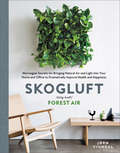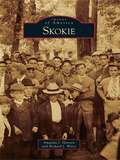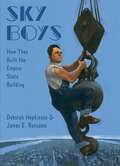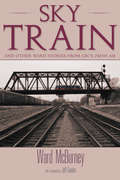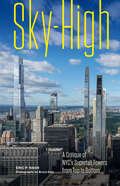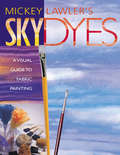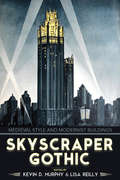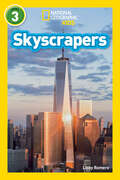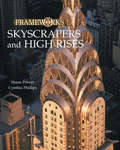- Table View
- List View
Skiing at Lake Tahoe (Images of America)
by Mark MclaughlinOrganized ski racing in America started near Lake Tahoe in the 1860s when gold miners rode 15-foot boards that reached speeds near 100 miles per hour. By 1895, residents of Truckee had started the nation's first winter carnival west of the Rocky Mountains and soon built the largest ski jump in California. Today's Lake Tahoe, with significant annual snowfall, has become home to the largest concentration of ski resorts on the continent. Places like Mount Rose, Squaw Valley (home of the 1960 Winter Olympics), Sugar Bowl, Heavenly Valley, Homewood, Sierra-at-Tahoe, Alpine Meadows, Kirkwood, Diamond Peak, Donner Ski Ranch, Granlibakken, and Northstar-at-Tahoe have seen skiing styles, sports, and fashions churn through the decades, while now gone resorts, such as Edelweiss and White Hills Ski Resort, echo the memories of yesterday's skiers through the pines.
Skiing in Colorado (Images of Sports)
by Colorado Snowsports Museum and Hall of Fame Dana MathiosSkiing in Colorado evolved from a transportation necessity to a world-class recreational pursuit. The first documented use of skis in Colorado occurred in the winter of 1859. As the popularity of the activity grew, ski resorts opened throughout the state. After World War II, Colorado saw a boom in the industry along with advancements in equipment, lifts, and safety; the development of ski schools; and the opening of new ski areas. This volume includes photographs from the Colorado Snowsports Museum that illustrate and celebrate the history of skiing in Colorado.
Skiing in Olympic National Park
by Roger Merrill OakesWith its glaciated peaks, temperate rain forests, and ocean wilderness, Olympic National Park has been called three parks in one. Efforts to protect and preserve these treasures began with the creation of a federal reserve in 1897, followed by a national monument in 1909, and then Olympic National Park in 1938. The 1920s and 1930s saw the building of many trails, shelters, and roads. In 1934, the US Forest Service completed a primitive road to the summit of Blue Mountain, affording skiing at Deer Park, and in 1957, the National Park Service completed an improved road to Hurricane Ridge. These two areas have offered alpine (lift-assisted) skiing to several generations. While these roads remain today, the recognition of the value of preserved wilderness has stopped road construction. In 1988, most of the park became federally designated wilderness. In 1981, Olympic National Park was designated a World Heritage Site.
Skiing in the Catskill Region (Images of Sports)
by George V. QuinnArriving by train to Phoenicia, New York, in the mid-1930s, downhill skiers first discovered the snowy trails of Simpson Ski Slope. Soon after, many Borscht Belt hotels were offering skiing and skating as ways to fill rooms during cold winter months when crowds thinned. In the high central Catskills, where abundant snowfall was a big draw, many abandoned rooming houses were commandeered to serve as base lodges for fledgling ski areas. In addition to farming and logging, skiing became an important industry to the area. People found steady employment in dozens of new areas sprouting all over the mountains. Downhill skiing is just part of the region's history. Ski jumping, racing, ski clubs, fashion, and colorful personalities were all part of the experience.
Skiing in the Mad River Valley
by Ellie Hilferty John HilfertyIn 1948, the first skiers to experience the steep and twisting downhill trails of Mad River Glen had to traverse muddy or frozen dirt roads to get to their destination. The warmth of a country inn was a comfort on those cold winter nights and continues as a hallmark of the Mad River Valley today. Even with the condo boom that developed after the opening of Sugarbush on Christmas Day in 1958, little has upset the ambience of the 20-mile-long valley. The valley developed a distinct personality, attracting "ski bums" who exchanged urban pressures for a laid-back lifestyle that continues today.
Skilletheads: A Guide to Collecting and Restoring Cast-Iron Cookware
by Ashley L. JonesPart science and part personal preference, collecting and restoring cast-iron cookware is a complex art. For instance, what makes each company's cast iron unique? Do chemicals used during restoration leach into food? When it comes to surface finish, is textured or smooth better?In Skilletheads, the highly anticipated follow-up to Modern Cast Iron, Ashley L. Jones dives deeper than ever into the world of cast iron. In these pages, which feature over 100 full-color photos, you'll find expert advice on purchasing cast iron from some of the most active collectors in the field today; side-by-side comparisons of the major manufacturers in the US and interviews with each company; and detailed how-to guides for restoring cast iron, including such methods as lye baths, electrolysis tanks, and chemical products, all compiled with input from devoted Skilletheads. And because no book on cast iron is complete without a little cooking, Jones includes 35 mouth-watering recipes contributed by foodies who know cast iron best—everything from Sunday Frittata to Braised Chicken to Skillet S'mores.Whether you're interested in finding the perfect pan for your kitchen or starting a new hobby restoring cast iron, Skilletheads is here to help.
Skin
by Rick Sammon Lee VarisRevised and thoroughly updated, this practical guide to photographing people is better than ever!What is the color of skin? You may think you know, until you enter the world of digital photography and try to reproduce what you see. Differences in software, lighting, computer calibration--everything has an impact on color. And that's all before you get into differences between people in terms of skin types, ethnicities, age, gender, and more! Hollywood-based photo-illustrator Lee Varis guides you step-by-step through the maze.This new edition covers the very newest trends and techniques in photographing, lighting, and editing skin--and offers plenty of tips, examples, and valuable advice from the author's own professional experience in the field.Shows you how to digitally capture all skin types: male, female, young, old, different skin tones and ethnicities, with makeup or without, wrinkled, tattooed, and moreCovers a wealth of topics in addition to photo editing, such as how to obtain model releases and compose shots, how to shoot groups, and how to create promotional headshotsIncorporates the latest on working with Photoshop and LightroomShowcases exceptional work from a variety of photographers and artistsIf you're photographing people, you'll want this valuable and unique guide on your shelf.
Skin Acts: Race, Psychoanalysis, and the Black Male Performer
by Michelle Ann StephensIn Skin Acts, Michelle Ann Stephens explores the work of four iconic twentieth-century black male performers--Bert Williams, Paul Robeson, Harry Belafonte, and Bob Marley--to reveal how racial and sexual difference is both marked by and experienced in the skin. She situates each figure within his cultural moment, examining his performance in the context of contemporary race relations and visual regimes. Drawing on Lacanian psychoanalysis and performance theory, Stephens contends that while black skin is subject to what Frantz Fanon called the epidermalizing and hardening effects of the gaze, it is in the flesh that other--intersubjective, pre-discursive, and sensuous--forms of knowing take place between artist and audience. Analyzing a wide range of visual, musical, and textual sources, Stephens shows that black subjectivity and performativity are structured by the tension between skin and flesh, sight and touch, difference and sameness.
Skin Color and Whiteness in Contemporary Art (Routledge Research in Art and Race)
by Helen WestgeestThis study demonstrates the significance of using contemporary art in scholarly debates about cultural aspects of skin, in particular “whiteness” as a phenomenon that is both overly visible and invisible.There is a need for a study of these artists’ strategies, which consist of drawing attention to whiteness by means of making whiteness “strange” through alternative visibilities. By increasing skin awareness, the selected socio-critical artworks also pertain to fostering visual literacy as another important contemporary concern. Chapters mainly focus on recent artworks that address ongoing skin-related debates in countries in Europe and North America, rooted in histories of ideology of white supremacy. Moreover, these artworks critically reflect on the alleged superiority of the history of Western European painting, including a focus on the representation of pale skin as model of beauty.The book will be of interest to scholars working in art history, race and ethnicity studies, and cultural studies.
Skin Shows: Gothic Horror and the Technology of Monsters
by Judith HalberstamIn this examination of the monster as cultural object, Judith Halberstam offers a rereading of the monstrous that revises our view of the Gothic. Moving from the nineteenth century and the works of Shelley, Stevenson, Stoker, and Wilde to contemporary horror film exemplified by such movies as Silence of the Lambs, Texas Chainsaw Massacre, and Candyman, Skin Shows understands the Gothic as a versatile technology, a means of producing monsters that is constantly being rewritten by historically and culturally conditioned fears generated by a shared sense of otherness and difference.Deploying feminist and queer approaches to the monstrous body, Halberstam views the Gothic as a broad-based cultural phenomenon that supports and sustains the economic, social, and sexual hierarchies of the time. She resists familiar psychoanalytic critiques and cautions against any interpretive attempt to reduce the affective power of the monstrous to a single factor. The nineteenth-century monster is shown, for example, as configuring otherness as an amalgam of race, class, gender, and sexuality. Invoking Foucault, Halberstam describes the history of monsters in terms of its shifting relation to the body and its representations. As a result, her readings of familiar texts are radically new. She locates psychoanalysis itself within the gothic tradition and sees sexuality as a beast created in nineteenth century literature. Excessive interpretability, Halberstam argues, whether in film, literature, or in the culture at large, is the actual hallmark of monstrosity.
Skin, Culture and Psychoanalysis
by Sheila L. Cavanagh Angela Failler Rachel Alpha Johnston HurstAn interdisciplinary study of skin bridging cultural and psychoanalytic theory to consider how the body's "exterior" is central to human subjectivity and relations. The authors explore racialization, body modification, self-harm, and comedic representations of skin, drawing from the clinical domain, visual arts, popular culture, and literature.
Skinny Habits
by Greg Critser Bob HarperBob Harper lets us in on the secret behaviors of people who not only lose weight but keep the pounds off for good--and make it look easy. In Bob Harper's #1 New York Times bestselling book The Skinny Rules, the trusted trainer and coach of NBC's The Biggest Loser laid out the twenty nonnegotiable eating rules for getting thin. In the process of helping countless men and women reach their weight loss goals, Harper has noticed six fundamental patterns in the lifestyle choices of those who succeed long-term--from the unique way they plan ahead to how they organize their environment and social calendars to even the way they dress. With his signature authority, colorful stories, and real-world solutions, Harper draws on the most up-to-date research related to habit formation, neuroplasticity, and cognitive behavioral psychology to show how feeding your brain--"the muscle between your ears"--can wield as much control over your weight as what you put in your mouth. With anecdotes about his clients, guided steps for adopting your new practices, and tips for integrating them into your own daily routine, Skinny Habits has everything you need to shape your body and your life!From the Hardcover edition.
Skins, Envelopes, and Enclosures: Concepts for Designing Building Exteriors
by Mayine L. YuIntegrate the best building envelope construction methods, materials science, and structural principles in your work using this book as a resource to help you… With more than seventy significant case studies located in North America, South America, Europe, and Asia from prehistory to the present, this book illuminates the theory and techniques of assembling exteriors. Six chapters organized by wall types, from hand-set monolithic walls to digitally fabricated curtain walls, each have a material focus section to help you understand their intrinsic properties so that you can decide which will best keep the weather out of your building. Examples from the ancient world, including the Pyramids and the Great Wall, through a range of renowned modern architects, such as Studio Gang, Sauerbruch Hutton, Herzog and deMeuron, and Rafael Moneo, illustrate how significant works in the history of architecture explored innovative use of materials – stone, brick, concrete, glass, and aluminium. Along the way, principles of construction from masonry and basic framing through ever more sophisticated envelope systems address classic problems presented by gravity, wind, rain, and sun with studies of lateral forces, building movements and materials that bridge the gaps in between them.
Skirt-a-Day Sewing: Create 28 Skirts for a Unique Look Every Day
by Nicole SmithDesign and sew your own fabulously stylish skirts. In this fun guide, Nicole Smith shows you how to draft a pattern for a custom fit and shape it into one of four basic silhouettes: wrap, straight, flared, and high-waisted. Each skirt can then be easily redesigned into seven distinct looks — one for each day of the week. Suitable for beginners and expert sewers alike, Skirt-a-Day Sewing will inspire you to express your unique personal style as you stitch up great new pieces for your wardrobe.
Skirts: Fashioning Modern Femininity in the Twentieth Century
by Kimberly Chrisman-CampbellIn a sparkling, beautifully illustrated social history, Skirts traces the shifting roles of women over the twentieth century through the era’s most iconic and influential dresses.While the story of women’s liberation has often been framed by the growing acceptance of pants over the twentieth century, the most important and influential female fashions of the era featured skirts. Suffragists and soldiers marched in skirts; the heroines of the Civil Rights Movement took a stand in skirts. Frida Kahlo and Georgia O’Keeffe revolutionized modern art and Marie Curie won two Nobel Prizes in skirts. When NASA put a man on the moon, “the computer wore a skirt,” in the words of one of those computers, mathematician Katherine G. Johnson. As women made strides towards equality in the vote, the workforce, and the world at large, their wardrobes evolved with them. They did not need to "wear the pants" to be powerful or progressive; the dress itself became modern as designers like Mariano Fortuny, Coco Chanel, Jean Patou, and Diane von Furstenberg redefined femininity for a new era. Kimberly Chrisman-Campbell's Skirts looks at the history of twentieth-century womenswear through the lens of game-changing styles like the little black dress and the Bar Suit, as well as more obscure innovations like the Taxi dress or the Pop-Over dress, which came with a matching potholder. These influential garments illuminate the times in which they were first worn—and the women who wore them—while continuing to shape contemporary fashion and even opening the door for a genderfluid future of skirts. At once an authoritative work of history and a delightfully entertaining romp through decades of fashion, Skirts charts the changing fortunes, freedoms, and aspirations of women themselves.
Skogluft: Norwegian Secrets for Bringing Natural Air and Light into Your Home and Office to Dramatically Improve Health and Happiness
by Jorn ViumdalThe simple, easy to understand Norwegian method for bringing nature into your home and office to help your health and mood.For millions of years, humans developed in natural environments, in close contact with sunlight, vegetation, water, and air. While we are biologically and physiologically similar to our Stone Age ancestors, most of us spend nearly all of our lives indoors, removed from the natural world. Studies have shown that spending time outdoors in or near nature delivers emotional, psychological, and physical benefits. Jorn Viumdal is on a mission to bring a natural living environment back to the home and workplace. In Skogluft—which translates to” forest air”—he draws on data from the University of Environmental Research and Bioscience in Norway and three decades of NASA research to reveal how a carefully chosen selection of plants grown and placed in a specific way indoors can dramatically improve health, reduce fatigue, strengthen the immune system, and enhance concentration, communication, and vitality. Having these plants around us can help improve how our bodies feel and prevent disease, make us happier and calmer, and increase our efficiency and productivity.Skogluft teaches you how to transform any wall in a home or office into a living wall to help remove toxins from the air, reduce stress, and strengthen the immune system. Viumdal explains which plants improve overall health and release different gases for optimal well-being. All the vegetation can be found in local nurseries or stores and online. Following Viumdal’s method, you will feel better, have more energy, and lift your spirits as you add natural beauty into your world.
Skokie (Images of America)
by Amanda J. Hanson Richard J. WitrySettled in the late 1840s and incorporated as Niles Centre in 1888, Skokie was founded by immigrants from Germany and Luxembourg who created a small-town rural community filled with farms and greenhouses. A short-lived real estate boom in the 1920s gave Skokie its current boundaries, streets, and sewer systems. Due to the Great Depression, however, these paved roadways remained vacant until after World War II. Aided by the construction of the Edens Expressway, Skokie experienced tremendous growth and became a bustling suburban community. Many of the families that settled in Skokie during this time were Jewish. In the last quarter century, other families moved to the suburb, many with Indo-Asian origins, leading to the ethnically diverse community that Skokie has become today.
Sky Boys: How They Built the Empire State Building
by Deborah HopkinsonThis Boston Globe–Horn Book Honor Book and ALA-ALSC Notable Children's Book provides a riveting brick-by-brick account of how one of the most amazing accomplishments in American architecture came to be. It&’s 1930 and times are tough for Pop and his son. But look! On the corner of 34th Street and 5th Avenue, a building straight and simple as a pencil is being built in record time. Hundreds of men are leveling, shoveling, hauling. They&’re hoisting 60,000 tons of steal, stacking 10 million bricks, eating lunch in the clouds. And when they cut ribbon and the crowds rush in, the boy and his father will be among the first to zoom up to the top of the tallest building in the world and see all of Manhattan spread at their feet.
Sky Color
by Peter H ReynoldsMarisol loves to paint. So when her teacher asks her to help make a mural for the school library, she can’t wait to begin! But how can Marisol make a sky without blue paint? After gazing out the bus window and watching from her porch as day turns into night, she closes her eyes and starts to dream. . . . From the award-winning Peter H. Reynolds comes a gentle, playful reminder that if we keep our hearts open and look beyond the expected, creative inspiration will come.
Sky Train: Stories from CBC's Fresh Air
by Ward Mcburney Jeff GoodesWhat do Northtrop Frye, French dairy cows, and Historic Fort York have in common? They're all part of Ward McBurney's lyric and personal stories from CBC Radio's Fresh Air, which are now available for the first time in print. <p><p> Broadcasting live on Saturday mornings, with Jeff Goodes as host, Ward has been performing his own work for over four years. Sky Train collects 35 of his creative non-fiction pieces, in which Isaac Brock, steam trains, dream trains, Fred Astaire, star fortifications, a tai chi master, truss bridges, ghost soldiers, lost loves, found objects, and, not the least, the author's pet turtle, all find a home. <p> A spirit of companionship and urban curiosity informs these stories, which cherish the marginalia of everyday life, while revealing that the past is always just around the present corner.
Sky-High: A Critique of NYC's Supertall Towers from Top to Bottom
by Eric P. NashPart architectural guidebook and part critique, Sky-High documents the pencil-thin, supertall towers that are transforming New York City's skyline as well as its streets.New York City's penchant for building skyward has reached new heights with its crop of supertall towers—those that rise at least 984 feet above the sidewalk. The city that never sleeps is also the city that never stops building ever higher, from the Woolworth and Chrysler buildings of an earlier race to the top to today's super luxury aeries of 57th Street's Billionaires' Row and the towers of the World Trade complex in Lower Manhattan.Bruce Katz's extraordinary photographs capture a dozen of these self-styled odes to wealth and power, alongside Eric P. Nash's incisive critique documenting the evolution of the skyline, past and present, and the supertalls' transformative effects on the contemporary cityscape. Among the twelve buildings featured are One World Trade Center, Three World Trade Center, 30 Hudson Yards, 35 Hudson Yards, One57, 432 Park Avenue, 53West53, Central Park Tower, and One Vanderbilt.
Skydyes: A Visual Guide to Fabric Painting
by Mickey LawlerA veteran fiber artist shares the basics of fabric painting, including step-by-step instructions to master techniques, and a list of necessary supplies.For Mickey Lawler, the sky is never the limit! Mickey’s SKYDYES fabric is well known among quilters and fiber artists as the finest individually hand-painted cotton available.• Perfect for beginning fabric painters, as well as those who have dabbled with fabric paints• Straightforward instructions explain Mickey’s painting techniques• Easy-to-follow exercises show how to create skies, earth, seas, and gardens• Learn how to choose appropriate fabrics, paints, and applicators• Handy “Paint Color and Mixing Chart”• Includes an easy quilt project that uses fabrics you create in the exercisesPraise for Skydyes“Skydyes takes an easygoing tutorial approach to teach quilters new aspects of their craft. Known for her beautiful hand-painted cotton fabrics, Lawler here teaches the art of fabric painting to those who would rather paint their own than buy custom-painted fabric. . . . An excellent choice.” —Library Journal
Skyscraper Gothic: Medieval Style and Modernist Buildings
by Kevin D. Murphy and Lisa ReillyOf all building types, the skyscraper strikes observers as the most modern, in terms not only of height but also of boldness, scale, ingenuity, and daring. As a phenomenon born in late nineteenth-century America, it quickly became emblematic of New York, Chicago, and other major cities. Previous studies of these structures have tended to foreground examples of more evincing modernist approaches, while those with styles reminiscent of the great Gothic cathedrals of Europe were initially disparaged as being antimodernist or were simply unacknowledged. Skyscraper Gothic brings together a group of renowned scholars to address the medievalist skyscraper—from flying buttresses to dizzying spires; from the Chicago Tribune Tower to the Woolworth Building in Manhattan.Drawing on archival evidence and period texts to uncover the ways in which patrons and architects came to understand the Gothic as a historic style, the authors explore what the appearance of Gothic forms on radically new buildings meant urbanistically, architecturally, and socially, not only for those who were involved in the actual conceptualization and execution of the projects but also for the critics and the general public who saw the buildings take shape.Contributors:Lisa Reilly on the Gothic skyscraper ● Kevin Murphy on the Trinity and U.S. Realty Buildings ● Gail Fenske on the Woolworth Building ● Joanna Merwood-Salisbury on the Chicago School ● Katherine M. Solomonson on the Tribune Tower ● Carrie Albee on Atlanta City Hall ● Anke Koeth on the Cathedral of Learning ● Christine G. O'Malley on the American Radiator Building
Skyscrapers (Readers)
by Libby RomeroLearn all about the world's most amazing skyscrapers – from the first, to the tallest, to how they're built, and everything in between – in this new National Geographic Kids Reader. The Level 3 text provides accessible, yet wide-ranging, information for fluent readers.
Skyscrapers and High Rises (Frameworks (group 1) Ser.)
by Cynthia Phillips Shana PriwerThis work includes a brief history of skyscrapers as well as chapters on elevators and communications, facades and facing, mechanical and electrical systems, forces of nature, and much more.
